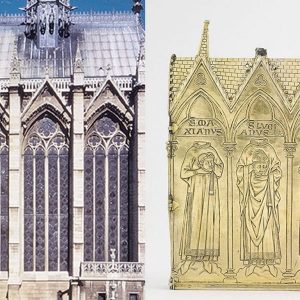 Appel à communications : « Scaling the Middle Ages: Size and Scale in Medieval Art », 24th Annual Medieval Postgraduate Colloquium (The Courtauld Institute of Art, 8 février 2019)
Appel à communications : « Scaling the Middle Ages: Size and Scale in Medieval Art », 24th Annual Medieval Postgraduate Colloquium (The Courtauld Institute of Art, 8 février 2019)
Date limite d’envoi : 16 novembre 2018
The Courtauld Institute of Art’s 24th Annual Medieval Postgraduate Colloquium invites speakers to consider issues and opportunities encountered by medieval artists and viewers in relation to size and scale.
From micro-architectural reliquaries and minute boxwood prayer beads to colossal sculpture and the built spaces of grand cathedrals and civic structures, size mattered in medieval art. Examples of simple one-upmanship between the castles and palaces of lords and kings and the churches and cathedrals of abbots and bishops are numerous. How big to make it was a principal concern for both patrons and makers of medieval art. Scale could be manipulated to dramatic effect in the manufacture of manuscripts and the relative disposition of elements within their decorative programmes. Divine proportions – of the Temple of Solomon or the Church of the Holy Sepulchre – were evoked in the specific measurements and configuration of contemporary buildings and decisions were made based on concern with numbers and number sequences.
Inspired by the ‘Russian doll’ relationship between the Sainte Chapelle in Paris and its micro-architectural miniature in the form of a gilded reliquary in the Musée de Cluny, Scaling the Middle Ages seeks to explore a range of questions surrounding proportion, scale, size, and measurement in relation to medieval art and architecture. The Sainte Chapelle, built by the saint-king of France Louis IX to house the relics of Christ’s Passion, is itself often described as an over-sized reliquary turned inside-out. The Cluny reliquary – made to house relics of Saints Maxien, Lucien, and Julien held within the chapel – both complicates and compliments that comparison, at once shrinking the chapel back down to size through close architectural quotation of its form in miniature and pointing the viewer’s attention back to that same, larger space. The relationship between these two artefacts raises a host of questions, including:
Scale and making
- How were ideas about size and scale communicated between patrons, architects, craftspeople, and artists? In an age without universal standardised units of measurement, how did craftsmen negotiate problems of scale and proportion?
- How were the measurements of a medieval building determined? What techniques did architects, masons, and artists use to determine the scale of their work?
Scale and meaning
- What effects were achieved and what responses evoked by the manipulation of scale, from the minute to the massive, in medieval art?
- What was the role of proportion and scale in architectural ‘copies’ or quotations?
- What representational problems were encountered by artists approaching out-sized subjects, such as giants?
- How was scale manipulated in order to communicate hierarchy or relative importance in medieval art?
- How did size and scale function in competition between patrons or communities in their artistic commissions and built environments?
Problems of scale
- What, if anything, happened when something was the wrong size? When was something too big, or too small? And how were such problems solved by patrons and makers?
- How does the disembodied viewing of medieval art through digital surrogates distort or assist in our perception of scale?
- How can modern measuring techniques and digital technology enhance our understanding of medieval objects and buildings?
Applicants to the colloquium are encouraged to explore these and related issues from a diverse range of methodologies, analysing buildings and objects from across the Middle Ages (broadly understood in geographical and chronological terms). The Medieval Postgraduate Colloquium offers an opportunity for research students at all levels from universities across the UK and abroad to present, discuss and promote their research.
To apply, please send a proposal of up to 250 words for a 20-minute paper, together with a CV, to teresa.lane@courtauld.ac.uk and oliver.mitchell@courtauld.ac.uk no later than 16 November 2018.
Organised by Oliver Mitchell and Teresa Lane (The Courtauld Institute of Art)
Click here for more information: https://courtauld.ac.uk/event/size-and-scale-in-medieval-art

Leave a Reply
You must be logged in to post a comment.